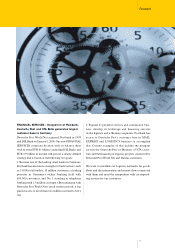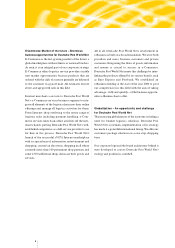DHL 1999 Annual Report Download - page 20
Download and view the complete annual report
Please find page 20 of the 1999 DHL annual report below. You can navigate through the pages in the report by either clicking on the pages listed below, or by using the keyword search tool below to find specific information within the annual report.
19
Management Report
U.S. market for domestic ground and air
transport of parcel and express items
A further comparison with the United States reveals the
potential that border-free parcel services have to offer.
According to the U.S.-based Parcel Shipper Association,
eight billion parcels were delivered in the U.S.A.in 1998.
This translates into approximately 30 parcels per
person. In Europe, the equivalent figure is only about
eight parcels per person.
Companies that are in a position to offer border-free
services within their own network will be able to take
advantage of these enormous opportunities. Package
solutions from a single source make life easier for the
customer. The volumes generated in this way make it
possible for service providers to use their networks to
full capacity and consequently offer attractive prices.
LOGISTICS
We define logistics as the process of planning,executing
and controlling the transport and warehousing of all
materials and goods and as the handling of attendant
information, from the first link in the supply chain to
the last one - in other words,right down to the end con-
sumer.
According to the International Monetary Fund, world-
wide commodity export volume has grown twice as fast
on annual average as production has since 1991.Accord-
ingly, cross-border transport business will continue to
increase in importance. Major factors fueling this trend
include e-Commerce, increased outsourcing and the
globalization of production and procurement. Here,
the market for integrated logistics solutions – which
especially benefits from the growing trend toward out-
sourcing in the industrial and service sectors – is a parti-
cularly fast-growing segment.
Still highly fragmented,the European logistics market is
marked by a large number of small and medium-sized
companies.The market trend is expected to lead to fur-
ther consolidation processes in both the European and
the international logistics markets.
Looking at the medium term, we expect those compa-
nies that offer the following conditions - which are criti-
cal to success - to be particularly successful in the logis-
tics market:
• Cost leadership arising from economies of scale since
networks have enormous overhead costs.
• An integrated range of one-stop-shopping services
that cover the entire logistics value-added chain –
including information and financial flows; services
that were designed for specific industries or sectors
and are supported by powerful, integrated IT systems
and strong partners.
• A range of worldwide services to help customers
expand their businesses into new parts of the world.
FINANCIAL SERVICES
A shift in customer behavior is currently triggering
changes in the banking market.Customers are demand-
ing higher quality from banking products and services.
In addition to traditional stationary sales operations at
retail outlets,customers are also taking advantage of an
increasing range of other services, such as:
• Self-service banking (in retail outlet premises, self-
service banking locations, as well as so-called points
of public);
• Call centers which offer customers the convenience of
making transactions at any time of the day;
• Home banking and Internet banking;
• Mobile sales operations and collaboration with distri-
bution partners (insurance agencies,retailers).
Percentage market share (1998)
All others 8.7%
FedEx/RPS 17.7%
UPS
48.2 %
USPS 25.4 %
Source: Report – The Colography Group, Inc.,
Atlanta, GA (August 10/31, 1999)
























